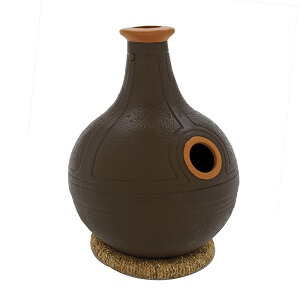Udu
 The udu drum originated from the Igbo people of Nigeria. Udu DrumUdu DrumUnlike other percussion instruments, the udu drum was invented and developed by the women of the Igbo people from clay pots. In fact, Udu means pot in Igbo. These clay pots are used to carry and store water from the river to their homes. Although the udu looks like an exotic instrument, the udu is a big part of the Igbo's way of life. You will find a lot of these pots littered in their homes. The udu is also used to store grain and other cultivated foods. The udu is a good nesting place for bee colonies, which then becomes a source of honey for the Igbo farmers.
The udu drum originated from the Igbo people of Nigeria. Udu DrumUdu DrumUnlike other percussion instruments, the udu drum was invented and developed by the women of the Igbo people from clay pots. In fact, Udu means pot in Igbo. These clay pots are used to carry and store water from the river to their homes. Although the udu looks like an exotic instrument, the udu is a big part of the Igbo's way of life. You will find a lot of these pots littered in their homes. The udu is also used to store grain and other cultivated foods. The udu is a good nesting place for bee colonies, which then becomes a source of honey for the Igbo farmers.
The function of udu as a household item and as a percussion instrument is not a coincidence especially in traditional cultures. The udu was used for women's ceremonies and rites. Eventually, the udu drum evolved into a percussion instrument in Christian churches in Africa and around the world. Udu drum is also used in reggae bands, African pop music, percussion musicals, and acoustic performances.
The side hole is the most important part of the udu drum. It is also the part that differentiates the udu drum from other African percussion instruments. You can control the deep bass tone of the udu drum by covering the hole in a rhythmic motion. Covering the hole and then immediately removing your hand produces an effect that causes the sound to sweep suddenly from a low pitch to a higher pitch. You can also temper the rise in pitch by gradually uncovering the hole as you tap the other side with your fingers. The udu drum has a range of one octave. Experienced udu drummers can make use of this range for a better percussion arrangement, which is something that is not possible with other percussion instruments.